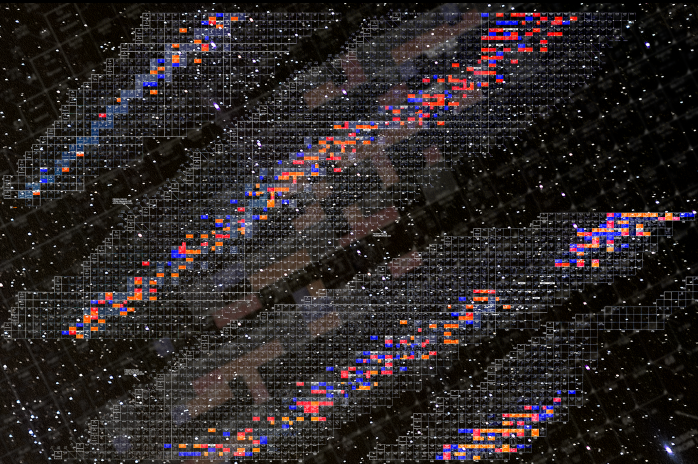Data
You will be redirected to cenamweb.org in 15 second(s). The JINA-CEE website is not updated anymore. The archived website can still be reached through the CeNAM website.
Vision
The Joint Institute for Nuclear Astrophysics - Center for the Evolution of the Elements (JINA-CEE) is a NSF Physics Frontiers Center for research at the intersection of nuclear physics and astrophysics. JINA-CEE research addresses fundamental questions about the evolution and properties of matter in the cosmos, and the origin of the chemical elements that makeup our world, as Carl Sagan aptly summarized: "We are made of star stuff". Understanding the origin and evolution of matter requires to study detailed features of atomic nuclei and connect them with observations of stars and stellar explosions.
JINA-CEE brings together nuclear experimentalists, nuclear theorists, astronomers, theoretical astrophysicists, and computational physicists in a unique cross-disciplinary research network that enables rapid communication and coordination across field boundaries and connects research at new accelerator facilities, observatories, and model codes in new ways.
JINA fosters interdisciplinary collaborations, workshops, research programs, and educational initiatives at its participating institutions as well as within the field of nuclear astrophysics at large. We invite the scientific community - astrophysicists and nuclear physicists - theorists and experimentalists - in the US and worldwide to actively participate in this endeavor to advance science and make this project a useful resource for the field of nuclear astrophysics.
"We are made of star stuff"
- Carl Sagan
Our History
JINA-CEE is the successor of the successful Joint Institute for Nuclear Astrophysics (JINA), which was founded in 1999 between the University of Notre Dame, Michigan State University, and the University of Chicago. Since 2002 JINA has been supported as a NSF Physics Frontiers Center. Today, the JINA-CEE network includes 26 institutions in 9 countries and about 300 scientific participants, including about 240 students and postdocs. Michigan State University currently serves as lead institution, and forms - together with the University of Notre Dame, Arizona State University, and University of Washington - the core of the center. JINA-CEE includes partnerships with international centers for nuclear astrophysics that have been inspired by JINA-CEE.
History of the Field
Right from its beginnings in the early 20th century, nuclear physics was inextricably connected with astrophysics - from explaining the seemingly infinite energy supply of the sun (1920 by Eddington, 1938/39 von Weizsaecker and Bethe) to the first attempts at a theory of the origin of the elements (1946 by Hoyle, 1957 by Burbidge, Burbidge, Fowler, and Hoyle; 1957 by Cameron), the discovery of the Hoyle state enabling the cosmic synthesis of carbon and oxygen at Caltech's Kellogg Radiation Laboratory (1957 by Fowler and co-workers) and the direct detection of neutrinos as nuclear messengers from the sun (in the 1960s by Davis) and later from supernova 1987A (by the Kamiokande OO, IMB, and Baksan collaborations).
Clemson Photo Gallery
View the Clemson photo archive in nuclear astrophysics. Within the PhotoArchive, you will find "many personal photographs of interest to the history and appreciation of nuclear astrophysics."
Future of the Field
New observations, advances in nuclear physics experimental capability, and ever increasing computer power continue to drive the field forward and have reached a stage where a now a more complete picture of the cosmic processes that create the elements is emerging.
 For example, large scale survey observations of rare metal poor stars provide a new window into novel element creating processes in the early Universe, and the detection of gravitational waves from a neutron star merger enables the study of extragalactic sites of heavy element creation via the r-process for the first time. Underground accelerator facilities and rare isotope facilities can study many of the nuclear processes in the cosmos in the laboratory to determine what elements are made in the various stellar element creating sites. Computational models of stars and stellar explosions are now advanced enough to enable full nucleosynthesis calculations in even the most sophisticated multi-D simulations of stars, supernovae, and neutron star mergers.
For example, large scale survey observations of rare metal poor stars provide a new window into novel element creating processes in the early Universe, and the detection of gravitational waves from a neutron star merger enables the study of extragalactic sites of heavy element creation via the r-process for the first time. Underground accelerator facilities and rare isotope facilities can study many of the nuclear processes in the cosmos in the laboratory to determine what elements are made in the various stellar element creating sites. Computational models of stars and stellar explosions are now advanced enough to enable full nucleosynthesis calculations in even the most sophisticated multi-D simulations of stars, supernovae, and neutron star mergers.
JINA and now JINA-CEE is driving many of these developments and connects advances in multiple fields in astronomy and nuclear physics towards a comprehensive understanding of the origin of the elements. Together with the community JINA-CEE developed a vision for the field as part of a Nuclear Astrophysics White Paper.
